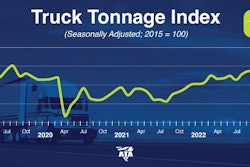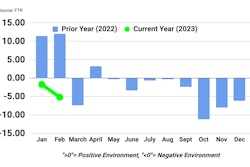While the freight cycle remains weak there are brighter days ahead, according to the latest release of the ACT Freight Forecast, U.S. Rate and Volume OUTLOOK report, as the tightly intertwined supply and demand dynamics in the freight market begin to recover with demand fundamentals improving and capacity starting to tighten.
“May will be pivotal for shippers, brokers and carriers,” said Ken Adamo, DAT’s chief of analytics. “After a challenging first four months of the year, we expect to see the effects of seasonality on freight volumes and rates. The question is how sustainable those effects will be.”
The for-hire trucking ton-mile index (TTMI), a report co-authored by Yemisi Bolumole, a Ryder endowed professor of Supply Chain Management at the University of Tennessee, and Jason Miller, associate professor of supply chain management and interim chair of the Department of Supply Chain Management at Michigan State University, shows there wasn't an expected seasonal bounce in freight volume in March, and TTMI shows no signs of an exit from the current freight recession on the horizon. "Though, hopefully, we won’t go back to the even lower levels that we saw in December 2022," Miller added. "In terms of macro-level planning, I would suggest carriers should expect aggregate demand for trucking to be 2% to 3% below levels this time in 2022 until we reach the back half of the year when comps become easier."
With a later than normal produce season this year, and the freight market likely passing the peak of the destock, freight demand is near the bottom, but Tim Denoyer, ACT Research’s vice president and senior analyst, added that easing inflation and improving real income trends will allow for a bit more holiday spending this year, "when even less destocking will mean more freight volume."
Data from Truckstop and FTR Transportation Intelligence for the week ending May 12 show a continued softening of broker-posted spot rates in the dry van and refrigerated segments that gave back roughly half the spot rate gains it had achieved in the prior two weeks. Dry van rates have declined in nine of the past 10 weeks, although the rate of decreases in recent weeks has been less recently. Flatbed saw a second straight week of declining rates, which had not occurred since January.
National average rates in April for contracted freight were lower compared to March, according to DAT, and the spread between contract and spot rates rose to near all-time highs: 62 cents for van freight, 60 cents reefer and 66 cents for flatbed.
Adamo called the gap between spot and contract rates “an indicator of where we’re at in the freight cycle — the balance of bargaining power among shippers, brokers and carriers," and for the gap to close, he said two things need to happen.
“One, the supply of trucks on the spot market needs to diminish, which unfortunately means more carriers exiting the market. Two, there needs to be higher demand for trucks — in other words, shippers with more loads than they planned for," he said.
Long-distance trucking employment is also contracting, as long-haul trucking jobs dropped by 8,700 jobs (1%) in the first quarter of the year. While still up 3.0% year-over-year in that latest March data point, the series will be down on a year-over-year basis by June on its current level, Denoyer said. "Since trends in employment follow trends in freight rates, long-haul jobs are set to decline this year," he added.
Interstate operating authorities are contracting at a record rate, with about 11,000 net revocations since last October, including about 1,600 net revocations in April, Denoyer said. "Total revocations were about 10,800 in April, near record levels," he added, "though grants and reinstatements are also elevated. This is beginning to tighten capacity, which will also help spot rates find the bottom and begin to rise.”
All trucking segments are virtually certain to see rate increases this week owing to the capacity disruption invariably caused by the Commercial Vehicle Safety Alliance's International Roadcheck event. The three-day period of intense roadside inspections runs May 16-18, and many truck drivers stay off the road during this time. With a decline in load postings and an increase in truck postings, the Market Demand Index fell to 55.6, which is its lowest level in several weeks, according to Truckstop and FTR.
"The intersection of additional volume and tightening capacity underpins our forecast for a near-term bottom in spot truckload rates," Denoyer said. "We’ve been expecting the bottom roughly around this month since we introduced 2023 spot rate forecasts 16 months ago, and we still think Roadcheck this week will help usher in a new freight cycle.”
Adamo noted that in 2016 and 2019, it was precisely the third week in May when the spot market entered a recovery phase after prolonged declines and stagnation. "Seasonality kicked in and shippers needed more trucks to move fresh produce, construction materials, imports and summer and back-to-school retail goods," he said. "If we see an uptick in demand before Memorial Day, it will be a welcome sign for owner-operators and small carriers as we head into the summer and fall.”













